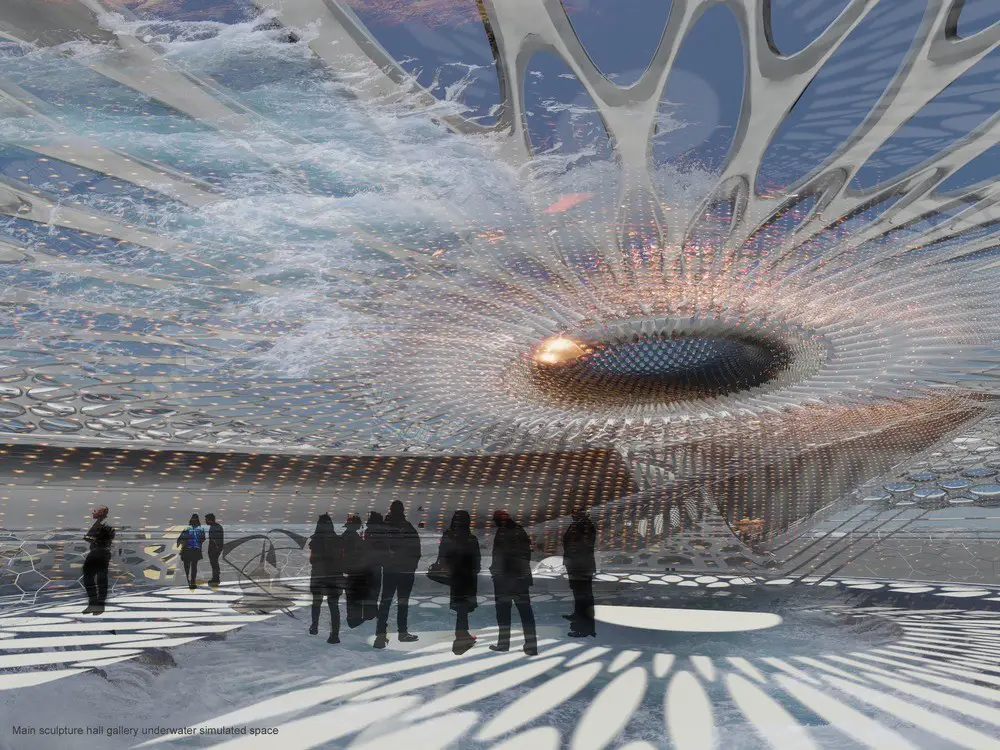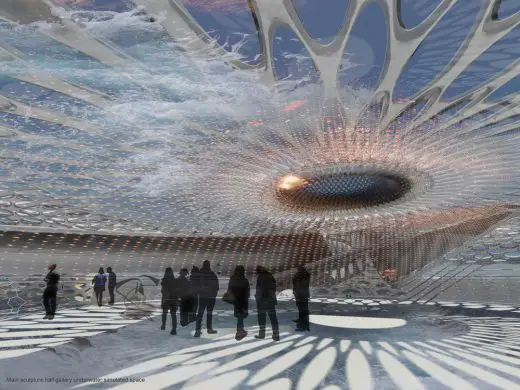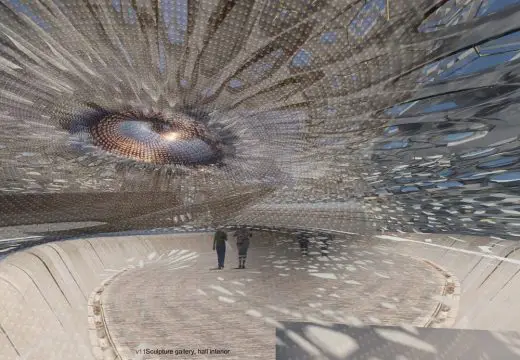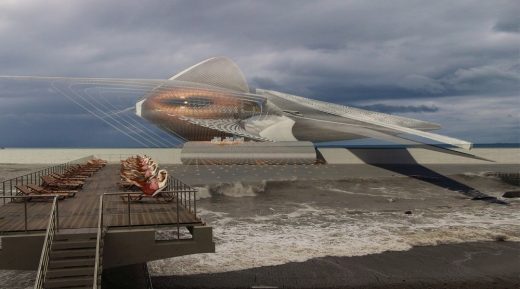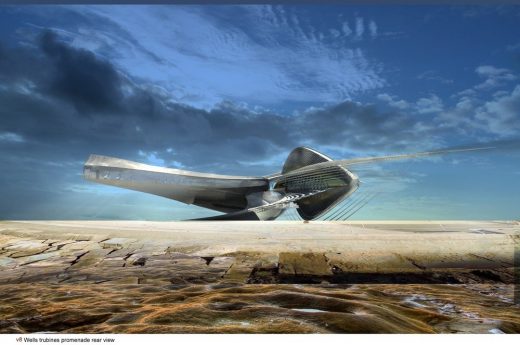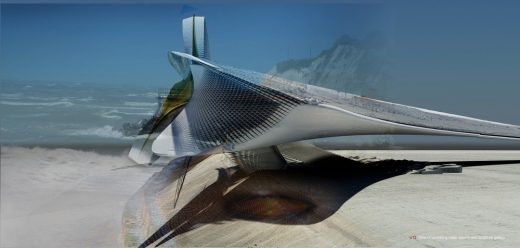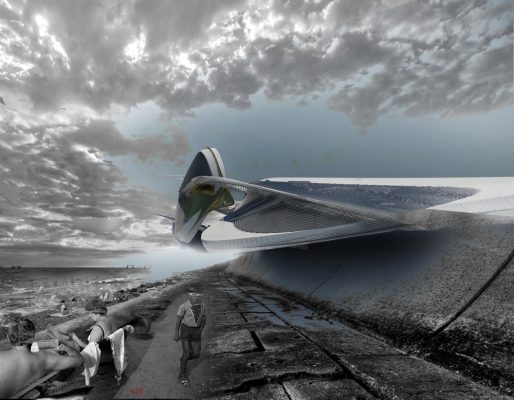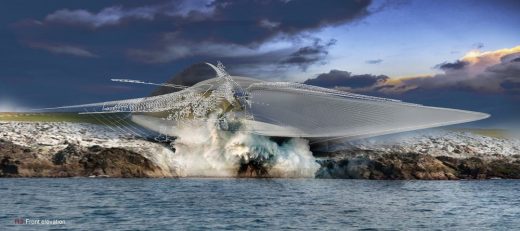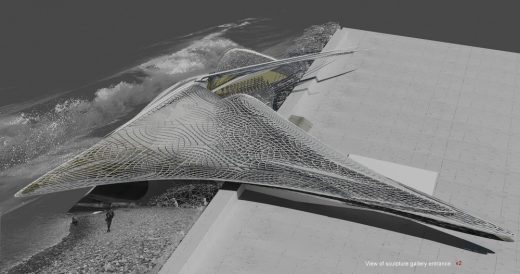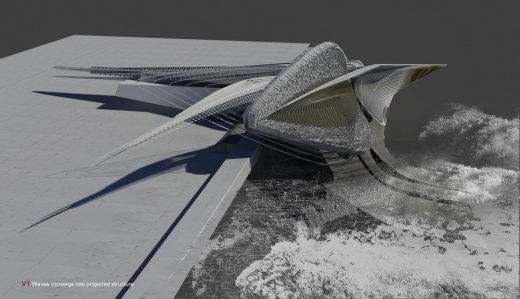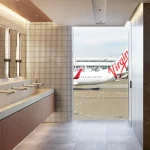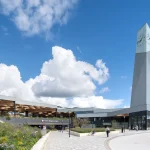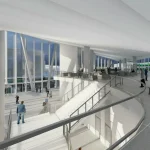Hydroelectric sculpture gallery, Sochi Building, Russian Architecture Design Images
Hydroelectric Sculpture Gallery in Sochi
Design: Margot Krasojević Archtecture
Location: Sochi, Russia
21 Feb 2020
Hydroelectric Sculpture Gallery
The design uses renewable energy to redefine typologies in architecture and the built environment. The site is located in Sochi, a coastal city on the Black Sea in Russia. The building uses the oscillating water column principle to harness wave energy, converting this mechanical energy to generate electricity; it also accommodates a sculpture gallery. This symbiotic program merges a small power plant capable of producing up to 300kW with a sculpture gallery to redefine typologies and accommodate self-sufficiency by generating sustainable energy that is fed back into the grid. This project aims to supply energy to 200 households and businesses within its vicinity.
The Black Sea is a contained body of water, an inland sea with a surprisingly strong swell and coastal wave energy potential, sufficiently effective for water turbine engineering. The building overhangs the coastline; projecting over the existing promenade, it is cantilevered and partly submerged into the sea, angled at 45 degrees to the coastline for maximum wave exposure. Similar to the nearby jetties, it increases wave generation as swell refracts around it to produce high-quality right-handers. The partly submerged projected element is designed to function as an oscillating water column, increasing tidal strength on impact with the building and reducing land erosion. The angle of the coastline sculpture gallery matches the angle of the swell, which, in turn, creates point break waves that do not lose their strength as they travel. The architecture influences the waves. It is not an obedient structure accommodating its environment.
Instead, it stands apart from it, making us reconsider our relationship with this environment and our immediate context. As wave energy converges against the projecting building element and sculpture gallery, it activates the oscillating water column section.
The art gallery comprises two areas connected by walkways and ramps – it rises out of the promenade, its primary steel structure sections rolling into each other like waves. An array of turbines line the partly submerged power plants oscillating on the water column surface. As seawater flows into the submerged chamber, airflow pressure increases, forcing the five Wells turbines located at the top of the chamber to rotate as the seawater rises and falls. Wells turbines always rotate in the same direction regardless of airflow direction. This mechanical energy is converted into electricity with an average 70% efficiency rate. Generators are positioned on the promenade to the rear of the building, revealing the very nature of the architecture and emphasising this hybrid typology. The small power plant feeds electrical energy back into the grid by supplying climate-friendly energy to approximately 200 homes and businesses in its vicinity.
The sculpture gallery is woven into the power plant structure – its roof rolls like a point break wave between both the energy plant and the sculpture gallery. The steel-clad layered ceiling mimics the waves by changing densities across its section from structural to cladding the self-supporting structure which projects the turbine water column into the surf.
The gallery’s open-plan space simulates breaking waves underwater to create a calm backdrop for the exhibited mobiles and sculptures. The roof’s cross-section comprises a frequency of densities that relate to the turbines in scale, whereby movement is the dynamic criteria for both parts of the design, be it mechanical or representational and sculptural. The waves which crash against the turbine surface are drawn up into the oscillating water column, splashing seawater onto the art gallery’s roof, thus adding to the dynamic nature of the immediate environment, program, and architecture.
This architecture employs new typologies for renewable energy to make it a priority of its design criteria. The mobiles and sculptures which predominantly focus on Russian constructivism reflect the very nature of the changing environment, attempting to work with and in a manner that choreographs nature’s effects even at its most hostile. This architecture does not solely blend in a submissive manner with the elements but also defines their movements to produce clean energy. It is not simply a subtle design for a static environment but it rather engages with nature’s forces. This has always been the intention in making renewable energy the motivation behind the design.
Russian constructivism was inspired by the industrial revolution and factories, reflecting the modern age by representing machine-influenced designs. Following a similar intention, this architecture brings together a new type of industrial typology, a synthesis between two extremely different programs working in sync like the crashing waves that sustain it.
An architecture that embraces the environment it is built into by not being overly cautious, it uses the environment’s characteristics to generate clean, sustainable energy, without affecting the quality and nature of the landscape. If these were hampered, we would be creating obsolete architecture with a short life term as it changes the very qualities of its environment. I do not believe in architecture that takes over environments, landscapes or immediate contexts at the cost of destroying the fundamental criteria driving this program. But at the same time, I also do not advocate for one that retains or suspends the environment, treating it as an exhibition piece. Preservation of the environment should be embraced using the environment efficiently and working with it to sustain us and itself. This demands a fine balance between intervention for a purpose and complete merging with the existing, which I find rather empty architecturally. I do not believe we need to be too cautious with the environment by making minimal design interventions. We need to understand the environment, and though it can certainly be hostile, we must build to exist with it and not to be subservient to it or destroy its nature.
Hydroelectric sculpture gallery, Russia – Building Information
Architects: Margot Krasojević
About Margot Krasojević:
Margot Krasojević completed her architectural education at the Architectural Association School of Architecture and University College London. She worked with Zaha Hadid Architects and was lead undergraduate and masters studio director, investigating digital and sustainable design programs, at UCL, University of Greenwich and University of Washington. She then opened a multidisciplinary architectural design studio focusing on integrating environmental issues, renewable energy and sustainability as part of the design process.
Margot Krasojević is currently working on projects in Asia, where she is integrating and harnessing renewable energy as part of a buildings service infrastructure. She is also designing hydroelectric homes and hotels which redefine how not only tourism but everyday rituals are affected and is investigating hempcrete as a sustainable and carbon-negative building material in her recent project for a Catalonian agricultural farm design. She is the author of “Dynamics and Derealisation” and “Spatial Pathologies-Floating Realities” and is a visiting professor at the University of Washington.
Margot Krasojević believes that a cross-disciplinary design strategy is very important for architecture proposing new typologies that reflect our perpetually changing environment. She focuses on design criteria that involve renewable energy sources and technology to develop a formal and structural architectural language supported by dynamic simulation software.
Margot Krasojević won the 2018 LEAF Award for “Best Future Building – Under Construction and Drawing
Board” for her “Self-Excavation Hurricane House” in Louisiana, US.
Margot Krasojević’s `Hydroelectric House’ design is a permanent exhibit at The Futurium, Berlin.
The Turbine hotel is part of a television documentary by RAUM Films, Austria.
Margot Krasojević is nominated for the Energy Globe awards 2020/21
and will be a featured guest speaker at the Anchorage Design Week, Alaska and deep-sea mining conference 2020.
Images: Margot Krasojević
Hydroelectric Sculpture Gallery in Sochi, Russia images / information received 210220 from v2com newswire
Location: Sochi, Russia
Architecture in Russia
Contemporary Architecture in Russia
Russia Architecture Designs – chronological list
Russian Buildings
Capital Hill Residence, Barvikha Forest, near Moscow, north west Russia
Design: Zaha Hadid Architects
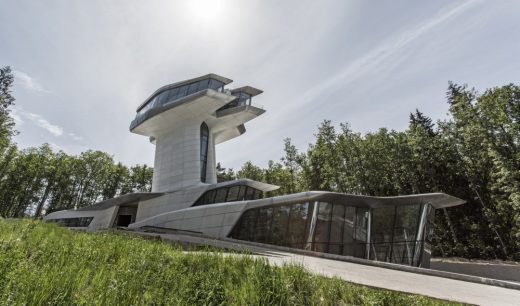
image courtesy of ZHA
Capital Hill Residence
Design: Zaha Hadid Architects
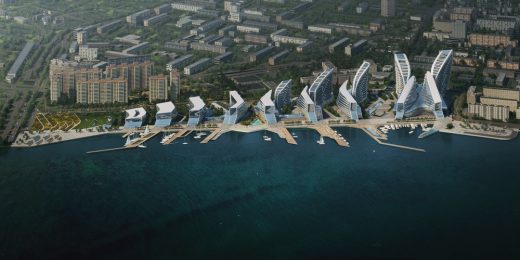
image : VA
Admiral Serebryakov Embankment Masterplan
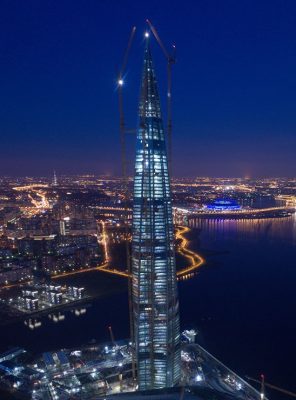
photo : Anton Galakhov
Lakhta Centre St Petersburg building news – Europe’s tallest tower
Riverside Terrace, Tatyshev Island
Design: OOO “ADM”, Architects
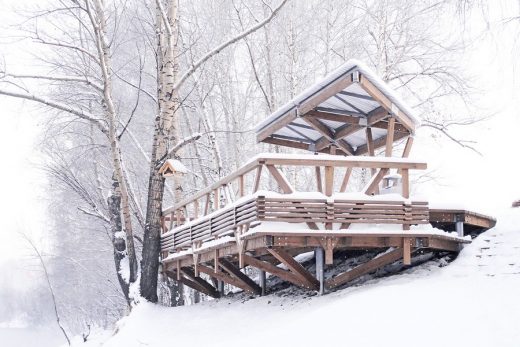
image courtesy of architects
Riverside Terrace on Tatyshev Island, Krasnoyarsk
St Petersburg Architectural Tours
Photos for the Hydroelectric Sculpture Gallery in Sochi, Russia page welcome
Website: Sochi, Russia

